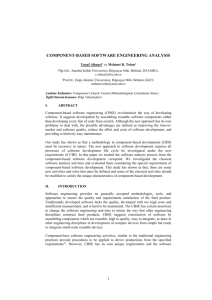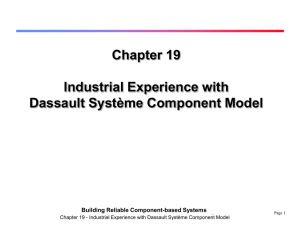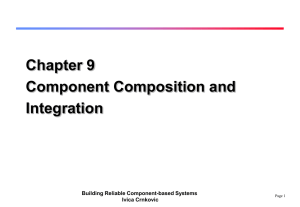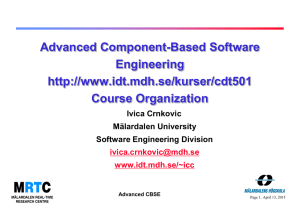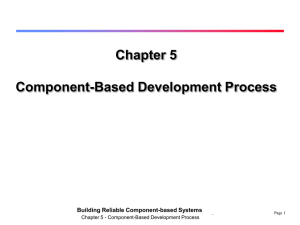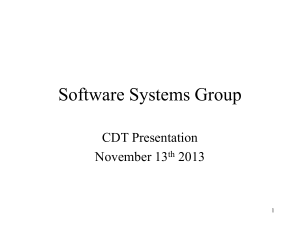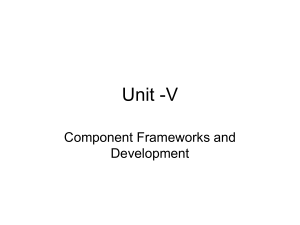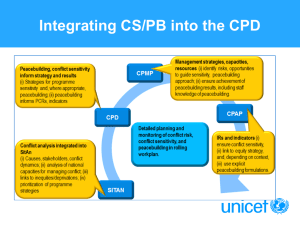Basic Concepts in Component-Based Software Engineering
advertisement
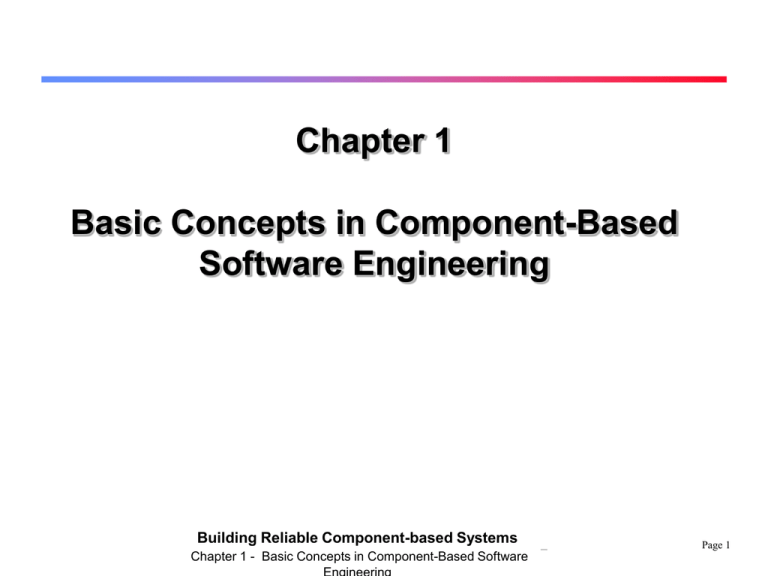
Chapter 1 Basic Concepts in Component-Based Software Engineering Building Reliable Component-based Systems Chapter 1 - Basic Concepts in Component-Based Software Page 1 Overview The Component Interfaces Contracts Patterns Frameworks Relationships between concepts Conclusion Building Reliable Component-based Systems Chapter 1 - Basic Concepts in Component-Based Software Page 2 What is a Component? We can find several definitions of a component in literature, however everyone agrees that a component is a piece of software. These definitions begin from the consideration of CBSE from different viewpoints and focus on different aspects of software engineering such as: Different phases (design, implementation and run-time phases), Business aspects, Architectural issues. Building Reliable Component-based Systems Chapter 1 - Basic Concepts in Component-Based Software Page 3 The Component: Szyperski Szyperski defines a component precisely by enumerating its characteristic properties as follows: A software component is a unit of composition with contractually specified interfaces and explicit context dependencies only. A software component can be deployed independently and is subject to composition by third party. Building Reliable Component-based Systems Chapter 1 - Basic Concepts in Component-Based Software Page 4 Implications of Szyperski’s Definition The following implications arise as a result of Szyperski’s definition: For a component to be deployed independently, a clear distinction from its environment and other components is required. A component must have clearly specified interfaces. The implementation must be encapsulated in the component and is not directly reachable from the environment . Building Reliable Component-based Systems Chapter 1 - Basic Concepts in Component-Based Software Page 5 The Component: D'Souza and Wills D'Souza and Wills define a component as A reusable part of software, which is independently developed, and can be brought together with other components to build larger units. It may be adapted but may not be modified. A component can be, for example, a compiled code without a program source, or a part of a model and/or design. Building Reliable Component-based Systems Chapter 1 - Basic Concepts in Component-Based Software Page 6 Describing a Component To be able to describe a component completely the component should consist of the following elements: A set of interfaces provided to, or required from the environment. An executable code, which can be coupled to the code of other components via interfaces. Building Reliable Component-based Systems Chapter 1 - Basic Concepts in Component-Based Software Page 7 Improving a Component To improve the component quality, the following elements can be included in the specification of a component: The specification of non-functional characteristics, The validation code, Additional information. Building Reliable Component-based Systems Chapter 1 - Basic Concepts in Component-Based Software Page 8 Objects and Components Pfister and Szyperski View a component as a collection of objects, in which the objects co-operate with each other, and are intertwined tightly. D'Souza and Wills Assert that if a class were packaged together with the explicitly defined interfaces which it requires and implements, then this class would be a component. Building Reliable Component-based Systems Chapter 1 - Basic Concepts in Component-Based Software Page 9 Objects and Components Continued The following are other important distinctions between objects and components: Components often use persistent storage whereas objects have local state. Components have a more extensive set of intercommunication mechanisms than objects which usually use the messaging mechanism. Components are often larger units of granularity than objects, and have complex actions at their interfaces. Building Reliable Component-based Systems Chapter 1 - Basic Concepts in Component-Based Software Page 10 Interfaces An interface of a component can be defined as a specification of its access point, offering no implementation for any of its operations. This seperation makes it possible to: Replace the implementation part without changing the interface; Add new interfaces (and implementations) without changing the existing implementation, Building Reliable Component-based Systems Chapter 1 - Basic Concepts in Component-Based Software Page 11 Describing an Interface Interfaces defined in standard component technologies using techniques such as Interface Definition Language (IDL) are: Sufficient in describing functional properties. Insuffiecient in describing extra-functional properties such as quality attributes like accuracy, availability, latency, security, etc. Building Reliable Component-based Systems Chapter 1 - Basic Concepts in Component-Based Software Page 12 Export and Import Interfaces We can distinguish two kinds of interfaces. Components can export/import interfaces to/from environments which may include other components. An exported interface describes the services provided by a component to the environment. An imported interface specifies the services required by a component from the environment. Building Reliable Component-based Systems Chapter 1 - Basic Concepts in Component-Based Software Page 13 Contracts A more accurate specification of a component's behavior can be achieved through contracts. A contract is comprised of: The Invariant, the global constraints which the component will maintain; The Pre-condition, the constraints which need to be met by the client; The Post-condition, the constraints which the component promises to establish in return. Building Reliable Component-based Systems Chapter 1 - Basic Concepts in Component-Based Software Page 14 How Contracts specify Component Interaction A contract specifies the interactions among components, in terms of: The set of participating components; The role of each component through its contractual obligations, such as type and casual obligations; The invariant to be maintained by the components; The specification of the methods which instantiate the contract. Building Reliable Component-based Systems Chapter 1 - Basic Concepts in Component-Based Software Page 15 Patterns Patterns define recurring solutions to recurring problems capturing non-obvious solutions, not just abstract principles or strategies. The solutions should be proven to solve the problem rather than being theories or speculations. Patterns describe relationships between deeper system structures and mechanism. A component, as a reusable entity, can be seen as a realization of some design pattern. Building Reliable Component-based Systems Chapter 1 - Basic Concepts in Component-Based Software Page 16 Three Categories of Patterns Patterns can be classified into three major categories: Architectural Patterns, capture the overall structure and organization of a software system. Design Patterns, refine the structure and the behavior of the subsystems as well as the components of a software system, and the relationships which exist between them. Idioms, are low-level patterns which are dependent on the chosen paradigm and the programming language used. Building Reliable Component-based Systems Chapter 1 - Basic Concepts in Component-Based Software Page 17 Design Patterns Design patterns are widely used in the process of designing component-based systems in which the reusable units must be identified. By using design patterns, it is easier to recognize those reusable parts and either find them in the form of preexisting components, or develop them as reusable units. Building Reliable Component-based Systems Chapter 1 - Basic Concepts in Component-Based Software Page 18 Software Frameworks CBSE means that we build software by "putting pieces together". Frameworks provide the context in which the pieces can be used. A framework may be seen as: A reusable design of a system, A skeleton of an application which can be customized by an application developer. Building Reliable Component-based Systems Chapter 1 - Basic Concepts in Component-Based Software Page 19 Component Frameworks While frameworks in general describe a typical and reusable situation at a model level, a component framework describes a “circuit-board” with empty slots into which components can be inserted to create a working instance. Coordination Services (transactions, persistence..) Building Reliable Component-based Systems Chapter 1 - Basic Concepts in Component-Based Software Component Framework Page 20 Component Models The two concepts Component Models and Component Frameworks are sometimes intermixed. A component model defines a set of standards and conventions used by the component developer whereas a component framework is a support infrastructure for the component model. Component model Building Reliable Component-based Systems Chapter 1 - Basic Concepts in Component-Based Software Page 21 Relationships Between Concepts Interface that satisfies contracts Component-type Specific interface Independent deployment Coordination Services (transactions, persistence..) Building Reliable Component-based Systems Chapter 1 - Basic Concepts in Component-Based Software Component implementation Component model Component Framework Page 22 Frameworks and Contracts Frameworks amd Components By the definition of frameworks as described earlier, a framework can be seen as a circuit-board (component framework) that is instantiated by filling in the empty slots. Building Reliable Component-based Systems Chapter 1 - Basic Concepts in Component-Based Software Page 23 Frameworks and Contracts Continued Frameworks and Contracts Frameworks focus on the overall properties of component compositions. Contracts give specifications for relationships between concrete components. These specifications may be different for components within one composition. Building Reliable Component-based Systems Chapter 1 - Basic Concepts in Component-Based Software Page 24 Frameworks and Patterns It is important to realize that design patterns and frameworks are distinct concepts of different natures. Design patterns are of a logical nature, representing knowledge of and experience gained with software. Frameworks are of a physical nature, and are executable software used in either the design or the runtime phase. Building Reliable Component-based Systems Chapter 1 - Basic Concepts in Component-Based Software Page 25 Frameworks and Patterns Continued The major differences between design patterns and frameworks are as follows: The level of abstraction of frameworks and design patterns; Design patterns are smaller architectural elements than frameworks; The level of specialization of frameworks and design patterns. Building Reliable Component-based Systems Chapter 1 - Basic Concepts in Component-Based Software Page 26 Conclusion Component specifications are essential for component users who are focused on the component features, functional and non-functional The main purpose of frameworks is to support the process of component composition Component developers must obey the rules and formats specified by the framework to develop and to specify the component, while component users will use frameworks to compose systems from components in a more efficient and accurate way. Building Reliable Component-based Systems Chapter 1 - Basic Concepts in Component-Based Software Page 27 Conclusion Continued Patterns give an abstract and more general view of a function, procedure or similar, which can be implemented in the form of systems or components Component designers will use patterns in the design process to design components more efficiently Building Reliable Component-based Systems Chapter 1 - Basic Concepts in Component-Based Software Page 28

